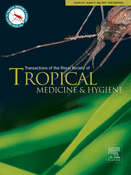-
Views
-
Cite
Cite
Roberta Ribeiro Silva, Camilo Adalton Mariano da Silva, Cíntia Aparecida de Jesus Pereira, Roney Luiz de Carvalho Nicolato, Deborah Negrão-Corrêa, Joel Alves Lamounier, Mariângela Carneiro, Association between nutritional status, environmental and socio-economic factors and Giardia lamblia infections among children aged 6–71 months in Brazil, Transactions of The Royal Society of Tropical Medicine and Hygiene, Volume 103, Issue 5, May 2009, Pages 512–519, https://doi.org/10.1016/j.trstmh.2008.10.019
Close - Share Icon Share
Summary
A cross-sectional study was conducted on a randomised sample of 405 children aged 6–71 months in Brazil to investigate the association between nutritional status, environmental and socio-economic factors and Giardialamblia infection. Data collection entailed an interview, anthropometric measurements and the collection of faeces and venous blood samples. The analysis was performed using multivariate logistic regression. The prevalence rate for G. lamblia was 26.3%. Nutritional status evaluation showed that 7.9% of the children had chronic malnutrition and 11.1% had acute malnutrition. The risk factors associated with infection by G. lamblia were an age of 2 years or older [odds ratio (OR) = 2.4], living in a two-bedroom house or smaller (OR = 2.3), living among a family of five or more people (OR = 2.4) and living in a house without access to a sewerage system (OR = 2.1). Non-participation in the social service programme was associated with a lower risk of infection (OR = 0.2). The model adjusted for age, including only biochemical and nutritional variables, showed weak associations with G. lamblia infection for two variables: inadequate animal protein intake according to the Dietary Reference Intake recommendation and low haemoglobin concentration. The sociodemographic and environmental risk factors classically described were associated with G. lamblia infection, but nutritional variables were only weakly associated with it.






Comments